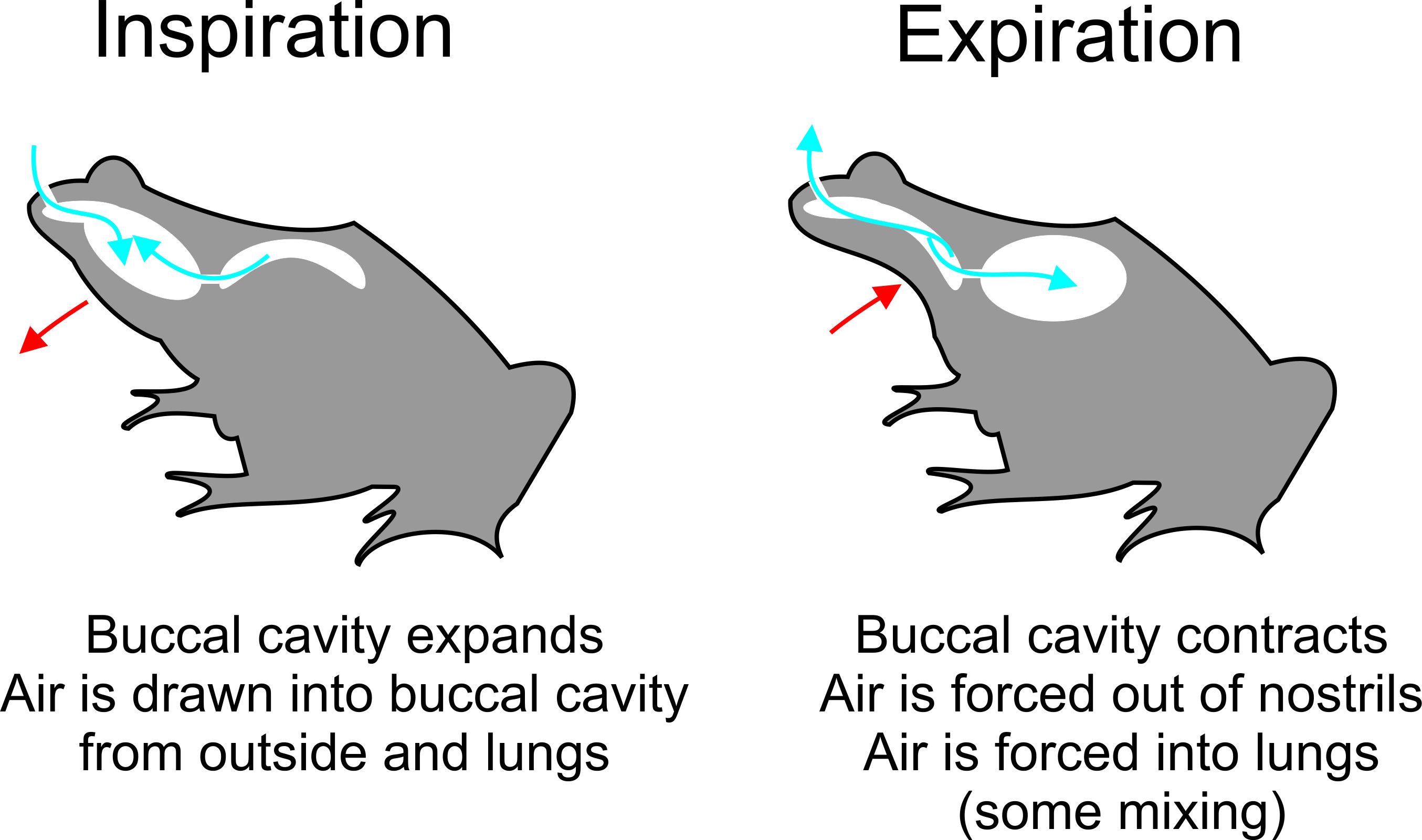Four-stroke Buccal Pumping on:
[Wikipedia]
[Google]
[Amazon]
Buccal pumping (/ˈbʌk.əl/...) is "breathing with one's cheeks": a method of ventilation used in


respiration
Respiration may refer to:
Biology
* Cellular respiration, the process in which nutrients are converted into useful energy in a cell
** Anaerobic respiration, cellular respiration without oxygen
** Maintenance respiration, the amount of cellul ...
in which the animal moves the floor of its mouth in a rhythmic manner that is externally apparent.Brainerd, E. L. (1999). New perspectives on the evolution of lung ventilation mechanisms in vertebrates. Experimental Biology Online 4, 11-28. http://www.brown.edu/Departments/EEB/brainerd_lab/pdf/Brainerd-1999-EBO.pdf It is the sole means of inflating the lungs in amphibian
Amphibians are ectothermic, anamniote, anamniotic, tetrapod, four-limbed vertebrate animals that constitute the class (biology), class Amphibia. In its broadest sense, it is a paraphyletic group encompassing all Tetrapod, tetrapods, but excl ...
s.
There are two methods of buccal pumping, defined by the number of movements of the floor of the mouth needed to complete both inspiration and expiration.
Four stroke
Four-stroke buccal pumping is used by some basal ray-finned fish and aquatic amphibians such as ''Xenopus
''Xenopus'' () (Gk., ξενος, ''xenos'' = strange, πους, ''pous'' = foot, commonly known as the clawed frog) is a genus of highly aquatic frogs native to sub-Saharan Africa. Twenty species are currently described with ...
'' and ''Amphiuma
''Amphiuma'' is a genus of aquatic salamanders from the United States, the only Extant taxon, extant genus within the family (biology), family Amphiumidae . They are colloquially known as amphiumas. They are also known to fishermen as "conger eel ...
''. This method has several stages. These will be described for an animal starting with lungs in a deflated state: First, the glottis
The glottis (: glottises or glottides) is the opening between the vocal folds (the rima glottidis). The glottis is crucial in producing sound from the vocal folds.
Etymology
From Ancient Greek ''γλωττίς'' (glōttís), derived from ''γ ...
(opening to the lung
The lungs are the primary Organ (biology), organs of the respiratory system in many animals, including humans. In mammals and most other tetrapods, two lungs are located near the Vertebral column, backbone on either side of the heart. Their ...
s) is closed, and the nostril
A nostril (or naris , : nares ) is either of the two orifices of the nose. They enable the entry and exit of air and other gasses through the nasal cavities. In birds and mammals, they contain branched bones or cartilages called turbinates ...
s are opened. The floor of the mouth is then depressed (lowered), drawing air in. The nostrils are then closed, the glottis opened, and the floor of mouth raised, forcing the air into the lungs for gas exchange. To deflate the lungs, the process is reversed.

Two stroke
Two-stroke buccal pumping completes the process more quickly, as is seen in most extant amphibians. In this method, the floor of the mouth is lowered, drawing air from both the outside and lungs into the buccal cavity. When the floor of the mouth is raised, the air is pushed out and into the lungs; the amount of mixing is generally small, about 20%.
Gular pumping
Gular pumping refers to the same process, but accomplished by expanding and contracting the entire throat to pump air, rather than just relying upon the mouth. This method of ventilation is inefficient, but is nonetheless used by all air-breathingamphibian
Amphibians are ectothermic, anamniote, anamniotic, tetrapod, four-limbed vertebrate animals that constitute the class (biology), class Amphibia. In its broadest sense, it is a paraphyletic group encompassing all Tetrapod, tetrapods, but excl ...
s and gular pumping is utilized to a varying extent by various reptile
Reptiles, as commonly defined, are a group of tetrapods with an ectothermic metabolism and Amniotic egg, amniotic development. Living traditional reptiles comprise four Order (biology), orders: Testudines, Crocodilia, Squamata, and Rhynchocepha ...
species. Mammal
A mammal () is a vertebrate animal of the Class (biology), class Mammalia (). Mammals are characterised by the presence of milk-producing mammary glands for feeding their young, a broad neocortex region of the brain, fur or hair, and three ...
s, in contrast, use the thoracic diaphragm
The thoracic diaphragm, or simply the diaphragm (; ), is a sheet of internal Skeletal striated muscle, skeletal muscle in humans and other mammals that extends across the bottom of the thoracic cavity. The diaphragm is the most important Muscles ...
to inflate and deflate the lungs more directly. Manta ray
Manta rays are large Batoidea, rays belonging to the genus ''Mobula'' (formerly its own genus ''Manta''). The larger species, ''Giant oceanic manta ray, M. birostris'', reaches in width, while the smaller, ''Reef manta ray, M. alfredi'', reac ...
embryos also breathe by buccal pumping, as mantas give live birth and embryos are not connected to their mother by umbilical cord or placenta as in many other animals.
See also
*Carrier's constraint
Carrier's constraint is the observation that air-breathing vertebrates with two lungs that flex their bodies sideways during locomotion find it difficult to move and breathe at the same time, because the sideways flexing expands one lung and comp ...
* Circular breathing
Circular breathing is a breathing technique used by players of some wind instruments to produce a continuous tone without interruption. It is accomplished by inhaling through the nose while simultaneously pushing air out through the mouth usi ...
References
{{DEFAULTSORT:Buccal Pumping Vertebrate anatomy